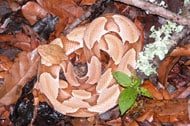Description:
Known also by the vernaculars of chunk head and highland moccasin, the venomous northern copperhead is a relatively slow moving, abundant, viperine snake. It is heavy bodied and has the namesake coppery-orange or coppery-russet head. Typically northern copperheads are clad in the colors of the fallen autumn leaves and are almost invisible as they sit in ambush, quietly coiled on the forest floor. Copperheads lack a well defined eye stripe. This is a front fanged species but the venom is relatively weak and expended in rather small volumes. One, or a pair, of northern copperheads may be maintained in a 30 to 50 gallon capacity terrarium. The substrate for these burrowing snakes may be of dry fallen oak and maple leaves, folded newspaper, several thicknesses of paper towels, aspen shavings or cypress shavings, or pelleted newspapers. Hiding areas in the form of small hollow logs or a plastic hidebox should be provided. A water bowl sufficiently large for the snakes to both drink and soak is provided. The water must be kept fresh and clean. Daytime illumination should be provided. A room temperature of 76 to 83 degrees Fahrenheit is a suitable temperature for the terrarium. Nighttime temperatures can drop into the high 60s. A daytime hot spot of about 92 to 95 degrees should be provided by a basking lamp. If kept merely as a pet, the northern copperhead may be kept warm and active all winter long and it will usually continue to eat. However, they may choose to miss a meal during the cooler winter months. If you intend to breed these snakes, they will probably require a 90 day period of dormancy. The northern copperhead preys upon insects (especially cicadas), amphibians, lizards, nestlings of ground dwelling birds, and small rodents. Many may be induced to accept mice. Northern copperheads are viviparous, giving birth to up to 17 young in a single annual (or biennial) clutch. The babies are paler than the adults but patterning is the same. Neonates are about 9 inches long. Care must be used in moving copperheads. Since they don’t sit on snakehooks well, a clampstick wielded gently but firmly is probably the best choice. .
Habitat:
Mixed woodlands, talus slopes, meadows, pastureland and along watercourses.
Range:
Southern New England to Maryland and westward to northern Alabama and southern Illinois.
Scientific Name: Agkistrodon contortrix mokasen
Species Group: venomous
Family: Viperidae
Size: Commonly attains 2½ feet in length; occasionally to slightly more than 4 1/3 feet
Level: advanced
Weight:
Dangerous: No



